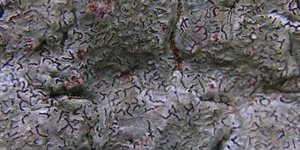Sticta fuliginoides
Spotting in the Field
In quantity this species is easy to spot by the distinctive form of the young thalli. It is rather more difficult to pick out when growing in small quality with Sticta ciliata. Clumps lacking young thalli would probably require experience to spot and microscopic work to confirm.Young Thalli
The young thalli are highly diagnostic, rapidly developing into a trumpet shape, which is generally taller than wide with steep angled sides. The young thalli of the other species in the group remain flat and are very different. Mature thalli of Sticta ciliata, do develop a similar shape, but this is wider than tall, has lower angled sides and has more markedly recurved margins. Marginal cilia are rare on Sticta fuliginoides and associated with damage.Mature Thalli
The maturing thalli become more like Sticta ciliata, with a rounded outline and shallowly crenulate margins but given an impression of being less regular in outline and have less strongly revolute margins. Old thalli can become quite large (up to 5cm), lacerate and lose their revolute margins.Summary
The main features are:- Young thalli very distinctive with trumpet or vase shaped thalli, with a tall and narrow silhouette, without marginal cilia.
- Small to medium sized mature thalli, rounded outline with recurved margins but less marked than Sticta ciliata.
- Confirmed microscopically by the sparse papillae on cyphella membrane cells (x400 & cross section)
Sticta fuliginoides pictures



